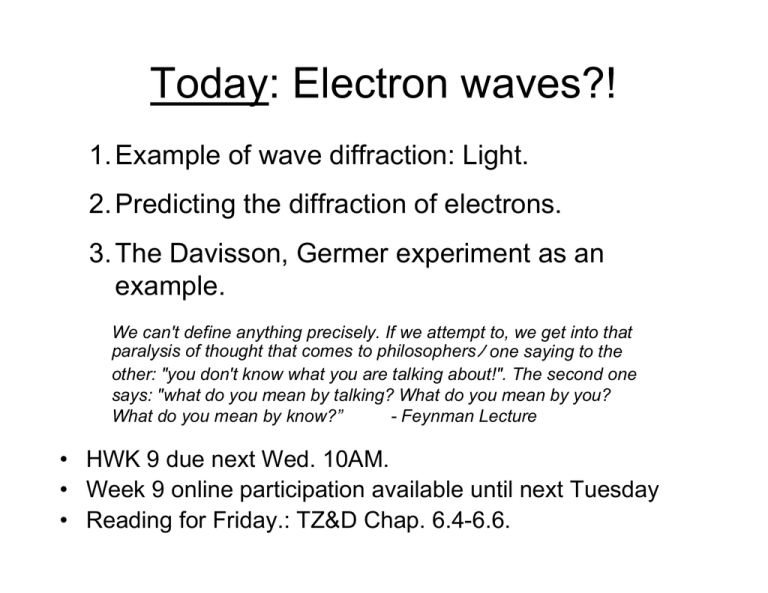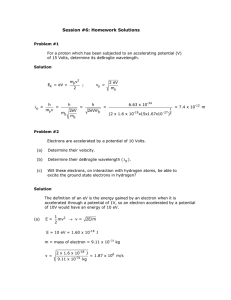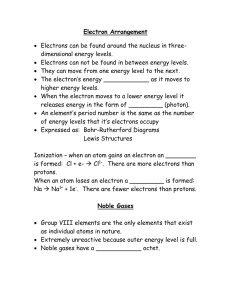Today: Electron waves?! - University of Colorado Boulder
advertisement

Today: Electron waves?! 1. Example of wave diffraction: Light. 2. Predicting the diffraction of electrons. 3. The Davisson, Germer experiment as an example. We can't define anything precisely. If we attempt to, we get into that paralysis of thought that comes to philosophersノ one saying to the other: "you don't know what you are talking about!". The second one says: "what do you mean by talking? What do you mean by you? What do you mean by know?” - Feynman Lecture • HWK 9 due next Wed. 10AM. • Week 9 online participation available until next Tuesday • Reading for Friday.: TZ&D Chap. 6.4-6.6. What deeper physical meaning comes from the Bohr Model’s successes?? Answer: deBroglie Waves • Explains quantization of L via λ=h/p. • Makes no other changes in Bohr Model. • But is it true? If electrons are waves, then shouldn’t there be other observed effects? • What would you need to see to believe that electrons are described by WAVES? • Today: Diffraction of electrons. How it works, why it was hard to see. Utility! Reading quiz. Young’s double slit experiment demonstrated that: a. white light is made up of many colors b. electrons are waves c. light is a wave d. light is made up of photons Two slit interference with light Meta-idea: Huygen’s Principle waves spread as spherical waves. Reminder- what do we mean by interference? Phet Wave Interference Sim 1 2 Waves (water, sound, …) interfering. Peaks where add, zilch where cancel (destructive interference) Question in 1920s So can we just do same experiment but replace beam of light with beam of electrons to check deBroglie? Let’s work through the design to see what expect to see, what required to do proper experiment. step 1. Go off and play with making beams of electrons. Find can make beams of energies between ~25-1000 V. V step 2. Calculate signal would expect to see from double slit. Typical for light-- 0.1 mm slits, 0.5 mm apart Can we just repeat light double slit experiment with electrons? a. yes. (if so, precisely what would experimental results would you expect?) b. no. (if so, precisely why not?) Double-slit experiment (see textbook) Determining the space between bright regions (H) L bright r1 0.5 mm =D H r2 θ bright Δr = r2-r1 Δr = mλ (where m=1,2,3…) θ1 D θ bright θ2 Δr = Dsin(θ)=Dθ =mλ Screen far away so θ1~θ2 ~θ & small angle approx. sinθ=θ H= Lsin(θ)=Lθ H=mLλ D Double-slit experiment Determining the space between bright regions (H) record equations on this slide! L r1 5 x10-4m = D θ H r2 Δr = r2-r1 Δr = mλ (where m=1,2,3…) Δr=mλ= Dsin(θ)=Dθ =mλ Calculating pattern for light m = 1, λ= 500 nm, so angle to first bright θ= λ/D = 500 x 10-9/(5 x 10-4) = 0.001 rad if L = 3m, then H= 3 m x 0.001 = 3mm. So what will pattern look like with electrons? How figure out? H= Lθ Steps to predict pattern for debroglie electron wave. 1. find expected wavelength λ=h/p, h = 6.6 x 10-34 J s 2. plug into θ= λ/D = (h/p)(1/D), calculate angle (radians) Best to do experiment with a. higher energy electron beam b. lower energy electron beam c. does not make any difference b. lower. Smaller energy ⇒ smaller momentum ⇒ larger λ means bigger angle, easier to see. Steps to predict pattern for debroglie electron wave. 1. find expected wavelength λ=h/p, h = 6.6 x 10-34 J s 2. plug into θ= λ/D = (h/p)(1/D), calculate angle (radians) For lowest energy electron beam (E = 25eV), how big is electron wavelength? A. λ ~ 1pm (10-12 m) D. λ ~ 1mm (10-3m) B. λ ~ 1nm (10-9 m) E. λ ~ 1m C. λ ~ 1μm (10-6 m) Compare with visible light: Energy E = ½mv2 = p2/2m λ ~ 400-700nm …so p = (2Em)1/2 …so λ = h/p = h/(2Em)1/2 λ = 6.6x10-34Js/(2 * 25eV * 1.6x10-19J/eV * 9.1x10-31kg)1/2 λ = 2.4 x 10-10 m = 0.24 nm ~ 1nm Energy and Momentum for Massive vs. Massless Particles Massive Particles (e.g. electrons) Lowest energy e-s • E = ½mv2 = p2/2m = h2/2mλ2 E = 25eV p = 2.7x10-24 kg m/s 1/2 • p = (2Em) v = 3x106 m/s = c/100 λ = 0.24 nm • λ = h/p = h/(2Em)1/2 Massless Particles (e.g. photons) Typical photons • E = pc = hc/λ E = 2.5eV p = 1.3x10-27 kg m/s • p = E/c v = c = 3x108 m/s • λ = h/p = hc/E λ = 500 nm deBroglie relationship is universal Steps to predict pattern for debroglie electron wave. 1. find expected wavelength λ=h/p, h = 6.6 x 10-34 J s 2. plug into θ= λ/D = (h/p)(1/D), calculate angle (radians) lowest energy 25 eV gives λ = 2.4 x 10-10 m So for slit separation D ~ 0.5mm, expect θ to be a. << 1, b. <1, c. >1, d. >>1. D θ = λ/D = (2.4 x 10-10 m)/(5 x 10-4m) = 4.9 x 10-7 radians!!! Much too small an angle to see! Big problem, if electron has wavelength λ deBroglie predicted it is REALLY SMALL ~ 2.4 x 10-10 m. Why not seen. Making lemonade out of lemons predict pattern for debroglie electron wave λ=h/p, h = 6.6 x 10-34 J s, θ= λ/D = (h/p)(1/D), λ = 2.4 x 10-10 m θ = λ/D if D = 5 x 10-4 m, θ = 4.9 x 10-7 radians Much too small an angle to see! What now? Any way to make angle bigger? a. make D much smaller, c. make D much bigger, e. b. and c. b. make electron energy lower, d. a. and b. ans. a) make D smaller (already said cannot make E smaller, electron beam no good) designing experiment to see debroglie electron wave λ=h/p, h = 6.6 x 10-34 J s, θ= λ/D = (h/p)(1/D) λ= 2.4 x 10-10 m θ= λ/D to make θ easy to see, like ~1rad, need D = 0.25 nm Is that a problem? yes, it is about the same size as one atom! Would like to have slits separated by about an atom diameter. Impossible. (here comes the lemonade) Brilliant idea: But two slits are just two sources. Hard to get two sources size of atom. Easy to get two objects that scatter electrons that are size of atom! But two slits are just two sources. hard to get only two atoms next to each other. But multiple that are same separation just work better. Just like reflection diffraction grating. Davisson and Germer -- VERY clean nickel crystal. Interference is electron scattering off Ni atoms. e e e e e e Ni e e det. e e scatter off atoms e e move detector around, see what angle electrons coming off See peak!! so probability of angle where detect electron determined by interference of deBroglie waves! # e’s 0 e e e e 500 scatt. angle θ e e det. e e e Ni Observe pattern of scattering electrons off atoms Looks like …. Wave! PhET Sim: Davisson Germer WARNING: for qualitative use only! (this is near field view) http://phet.colorado.edu/simulations/schrodinger/dg.jnlp λ=h/p, h = 6.6 x 10-34 J s, θ= λ/D = (h/p)(1/D) See peak!! so probability of angle where detect electron determined by interference of deBroglie waves! # e’s 0 500 scatt. angle θ Radical idea, want to check as carefully as possible. What else does deBroglie wave idea predict that can check? If increase energy, what will peak do? a. get larger θ c. shift to smaller b. get smaller angle as 1/p. Higher c. shift to smaller angle E, higher p, smaller θ. 1/p d. shift to larger angle Dav.-Germ. tried, data e. get wider agreed exactly. Models of the Atom • Thomson – Plum Pudding – – – – – – Why? Known that negative charges can be removed from atom. – Problem: just a random guess • Rutherford – Solar System – Why? Scattering showed hard core. – Problem: electrons should spiral into nucleus in ~10-11 sec. + • Bohr – fixed energy levels – Why? Explains spectral lines. – Problem: No reason for fixed energy levels + • deBroglie – electron standing waves – Why? Explains fixed energy levels – Problem: still only works for Hydrogen. • Schrodinger – quantum wave functions – Why? Explains everything! – Problem: None (except that it’s hard to understand) + – Electron wave measurements important to understand QM ALSO VERY COOL APPLICATIONS (excellent lemonade) 1) Low energy electron diffraction (LEED) standard tool in material science exactly D. G. experiment- measure surface properties •atoms at random locations (“amorphous”), no peaks •nicer the crystal, better the peaks •measure distance between atoms in crystal, D=λ/θ 2) Electron microscope Use electrons just like light waves, lenses etc. (usually transmission rather than scattering) microscope resolution ~λ. Electron λ’s thousands to millions less than light λ’s. Modern evidence of matter waves. Double-slit experiment with matter: Electrons, Protons, Neutrons, Buckyballs (60 carbons)! Send electrons one at a time through double slit…. 1973: λ=0.004nm & D=3μm & screen 16 cm away 200nm eeee D Similar to case with photons… Interference pattern builds up one electron at a time Each electron must be a wave, going through both slits, interfering with itself. At screen, electron localizes to a point where detected. Double-slit experiment with matter: electrons! After slit, wave spreads in all directions W om r f s ave e r e f r te n i y l ve i t c u tr s n o c slits Double-slit experiment with matter: electrons! Determining the space between peaks (H) L r1 D H r2 θ Δr = r2-r1 Δr = mλ (where m=1,2,3…) θ1 D θ If screen far away θ1 ≈ θ2 ≈ θ θ2 H= Lsin(θ)=Lθ Δr = Dsin(θ)=Dθ =mλ H=mLλ D (small angle approx: sin (θ) = θ) Double-slit experiment with matter: electrons! H=mLλ D m=1,2,3,… L r1 D θ H r2 If we use protons instead (protons going at same speed as electrons were), what happens to the spacing between peaks, H? a. increases b. stays the same c. decreases C. DeBroglie wavlength: λ=h/p p=mv; bigger mass Æ bigger p Æ smaller λ Æ smaller H (need smaller D or slower protons to see interference as easily) Models of the Atom • Thomson – Plum Pudding – – – – – – Why? Known that negative charges can be removed from atom. – Problem: just a random guess • Rutherford – Solar System – Why? Scattering showed hard core. – Problem: electrons should spiral into nucleus in ~10-11 sec. + • Bohr – fixed energy levels – Why? Explains spectral lines. – Problem: No reason for fixed energy levels • deBroglie – electron standing waves – Why? Explains fixed energy levels – Problem: still only works for Hydrogen. • Schrodinger – will save the day!! + + –



